AMAZON multi-meters discounts AMAZON oscilloscope discounts
1. Introduction to Strain Gages
Strain gages are used in many types of sensors. They provide a convenient way to convert a displacement (strain) into an electrical signal. Their "output" is actually a change of resistance. It can be converted to a voltage signal by connecting the strain gage(s) in a bridge configuration. A few sensors use only a single strain gage element in the bridge, along with three fixed resistors. Others use two strain gages and two fixed resistors, and most recent designs use four strain gages. The gages may be almost any material, but some materials are much more efficient strain gages than others. Proprietary metal alloys and semiconductor silicon are the most commonly used materials.
Piezoresistance
A piezoresistor is a device that exhibits a change in resistance when it is strained.
There are two components of the piezoresistive effect in most materials--the geometric component and the resistive component.
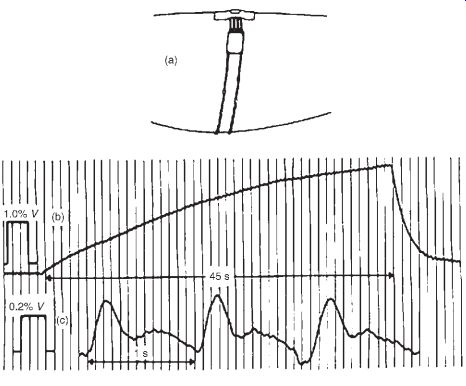
FIG. 1.1: Liquid strain gage: mercury tube.
The geometric component of piezoresistivity comes from the fact that a strained element undergoes a change in dimension. These changes in cross-sectional area and length affect the resistance of the device.
A good example of the geometric effect of piezoresistivity is the liquid strain gage.
A great many of these devices were in use years ago. Imagine an elastic tube filled with a conductive fluid, such as mercury. The resistance of the mercury in the tube can be measured with a pair of metal electrodes, one at each end, as shown in FIG. 1.1. Since mercury is essentially incompressible, forces applied along the length of the tube stretch it, and also cause the diameter of the tube to be reduced, with the net effect of having the volume remain constant. The resistance of the strain gage is given by
R = (resistivity of mercury)(length of tube)/(cross-sectional area of tube)
Since

We define a quantity called the gage factor K as:
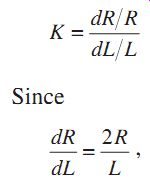
we have K = 2 for a liquid strain gage.
This means that the fractional change in resistance is twice the fractional change in length. In other words, if a liquid strain gage is stretched by 1%, its resistance in creases by 2%. This is true for all liquid strain gages, since all that is needed is that the medium be incompressible.
Liquid strain gages were in use in hospitals for measurements of fluctuations in blood pressure. A rubber hose filled with mercury was stretched around a human limb, and the fluctuations in pressure were recorded on a strip-chart recorder, and the shape of the pressure pulses were used to diagnose the condition of the arteries. Such devices have been replaced by solid-state strain gage instruments in modern hospitals, but this example is still interesting from an introductory standpoint.
Metal wires can also be used as strain gages. As is true for the liquid strain gage, stretching of the wire changes its geometry in a way that acts to increase the resistance. For a metal wire, we can calculate the gage factor as we did for the liquid gage, except that we can't assume the metal is incompressible, and we can't assume the resistivity is a constant:
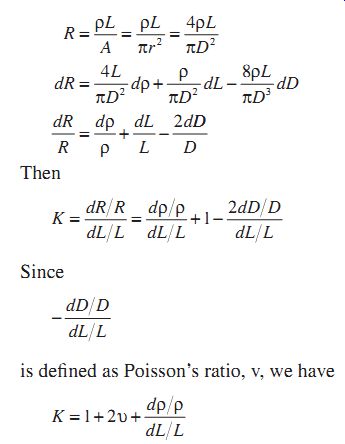
For different metals, this quantity depends on the material properties, and on the details of the conduction mechanism. In general, metals have gage factors between 2 and 4.
Now, since the stress times the area is equal to the force, and the fractional change in resistance is equal to the gage factor times the fractional change in length (the strain), and stress is Young's modulus times the strain, we have

So the fractional change in resistance of a strain gage is proportional to the applied force and is proportional to the gage factor divided by Young's modulus for the material. Clearly, we would prefer to have a large change in resistance to simplify the design of the rest of a sensing instrument, so we generally try to choose small diameters, small Young's modulus, and large gage factors when possible. The elastic limits of most materials are below 1%, so we are generally talking about resistance changes in the 1%-0.001% range. Clearly, the measurement of such resistances is not trivial, and we often see resistance bridges designed to produce voltages that can be fed into amplification circuits.
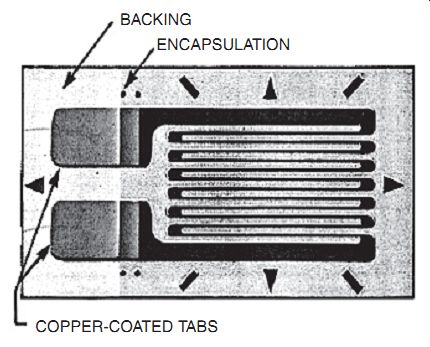
FIG. 1.2: Thin film strain gage.
Thin Film Strain Gages
For many years, there has been an industry associated with the fabrication and marketing of thin metal film strain gages and the necessary tools and equipment for attaching these gages and the wires to various mechanical structures. A photograph of a thin film strain gage is shown in FIG. 1.2. This particular strain gage consists of a metal wire patterned so that it is primarily sensitive to elongation in one direction. Strain gages are available from several vendors, and literally hundreds of patterns of the metal film can be selected, with different patterns providing sensitivity to strain in particular directions. In recent years, much use has been made of the fact that doped silicon is a conductor that exhibits a gage factor as large as 200, depending on the amount of doping. This creates an opportunity to make strain gages from silicon, and to use them to produce more sensitive devices than would be easy to make in any other material.
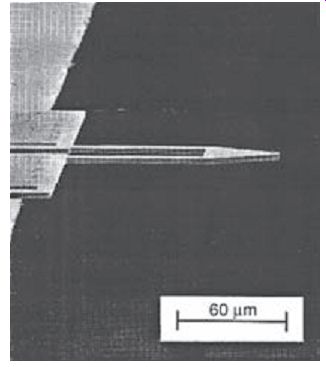
FIG. 1.3: Silicon strain gage.
Microdevices
Another aspect of the utility of silicon is that recent years have seen the development of a family of etching techniques that allow the fabrication of micromechanical structures from silicon wafers. Generally referred to as silicon micromachining, these techniques use the patterning and processing techniques of the electronics industry to define and produce micromechanical structures.
Micromachining can be used to fabricate piezoresistive cantilevers for a wide variety of applications. Recent research (Ben Chui at Stanford and John Mamin at IBM Almaden) has focused on the development of piezoresistive cantilevers for data storage applications. In this design, a 100 micron-long piezoresistive cantilever is dragged along a polycarbonate disk at 10 mm/s, bouncing up and down as it passes over sub-micron indentations in the surface of the disk. This idea is essentially a high-performance phonograph needle. The devices shown in FIG. 1.4 illustrate cantilevers developed for this data storage application. Since 2000, researchers at IBM Zurich, led by Vettiger, have been making large 2-D arrays of piezoresistive cantilevers suitable for a high-density data storage system based on this approach.

FIG. 1.4: AFM thermo-mechanical data storage.
A great deal more could be said about these techniques, but for now we simply state that these techniques are capable of producing diaphragms and cantilevers of silicon with thickness of microns and lateral dimensions of hundreds of microns up to millimeters (see FIG. 1.3). The mechanical properties of these structures are exactly what we would expect from the bulk mechanical characteristics of silicon.
Since these microstructures can have sensitive strain gages embedded in them, it is easy to see that a number of useful sensing devices can be built. Particular examples include strain gage-based pressure sensors, where an array of strain gages can be positioned around the perimeter of a thin diaphragm and connected into a bridge configuration to automatically cancel out other noise and drift signals from the gages.
Strain Gage Accuracy
Another issue associated with strain gages is the accuracy of the resistance measurement. Generally, accuracy is improved by using larger currents and producing larger voltage changes. However, the practical limit to the amount of current that can be used comes about due to power dissipation in the resistive element. For this reason, the technologies for bonding thin film strain gages have been optimized to maximize the thermal conduction from the thin film to the substrate. Improving the thermal conductance enables the use of more current in the measurement.
Many strain gages, and particularly doped silicon strain gages, are sensitive to temperature changes. In some cases, this is a useful effect-especially if the application also needs to measure temperature. Generally, this is not the case, so it is necessary to compensate for this sensitivity. The easiest way to do this is to fabricate reference resistors from the same material, and locate them so that they do not sense the strain signal. A bridge configuration can be easily arranged to retain the strain sensitivity while canceling the temperature sensitivity of an array of strain gages. Such arrangements are very important and easily produced, so they are very common.
Applications
The applications of strain gages are in sensors where medium-to-large amounts of strain are expected to occur (0.001%-1%), where very low-cost devices are needed, where miniature silicon devices are necessary, and where signals are expected at frequencies from DC to a few kHz. The frequency limitation comes about because the bonding configuration of these devices generally leads to large stray capacitance, which tends to filter out rapidly varying signals.
Example Calculation: Piezoresistive Cantilever

FIG. 1.5: Piezoresistive cantilever.
This example calculation and figure are taken from the thesis of Dr. Marco Tortonese, in which fabrication and operation of an AFM based on piezoresistive cantilevers are described in detail. The calculation of the sensitivity of a piezoresistive cantilever is presented here to provide an example of the strain gage calculations.
As shown in FIG. 1.5, we use a piezoresistive cantilever to sense variations in the shape of a surface which is passed beneath. This technique has been demonstrated as the Atomic Force Microscope (AFM) by several graduate students in the group of Cal Quate at Stanford. In AFM, attractive forces between a sharp tip and a sample surface cause slight cantilever deflections. If the cantilever is thin enough, forces associated with atomic interactions between individual atoms can be measured.
The load-deflection relationship for a simple cantilever beam is
[...]
Since doped silicon has a gage factor of about 100, we would expect a change in resistance dR/R of 0.03% for this example.
In fact, the cantilever does not take on a circular deflection, and the strain is largely concentrated at the base. If we place our strain gage at the base, we can expect a strain enhancement of order 5-10 times, thereby increasing the resistance change.
With a good circuit it is possible to measure resistance changes as small as one part in 106 , so this is indeed a reasonable measurement. It is not simple, but it is possible.
In many cases in AFM, forces as small as 10-10 N are measured, which requires a careful electrical circuit design.
2. Strain-Gage Based Measurements
The most popular electrical elements used in force measurements include the resistance strain gage, the semiconductor strain gage, and piezoelectric transducers. The strain gage measures force indirectly by measuring the deflection it produces in a calibrated carrier. Pressure can be converted into a force using an appropriate transducer, and strain gage techniques can then be used to measure pressure. Flow rates can be measured using differential pressure measurements which also make use of strain gage technology.
¦ Strain: Strain Gage, Piezoelectric Transducers
¦ Force: Load Cell
¦ Pressure: Diaphragm to Force to Strain Gage
¦ Flow: Differential Pressure Techniques

FIG. 2.1: Strain-gage based measurements.
The resistance strain gage is a resistive element which changes in length, hence resistance, as the force applied to the base on which it is mounted causes stretching or compression. It is perhaps the most well-known transducer for converting force into an electrical variable.
Unbonded strain gages consist of a wire stretched between two points as shown in FIG. 2.2. Force acting on the wire (area = A, length = L, resistivity = p) will cause the wire to elongate or shorten, which will cause the resistance to increase or decrease proportionally according to:
R = pL/A and fir/R = GFfil/L,
where GF = Gage factor (2.0 to 4.5 for metals, and more than 150 for semiconductors). The dimensionless quantity fil/L is a measure of the force applied to the wire and is expressed in microstrains (1µe = 10^-6cm/cm) which is the same as parts-per-million (ppm). From this equation, note that larger gage factors result in proportionally larger resistance changes-hence, more sensitivity.
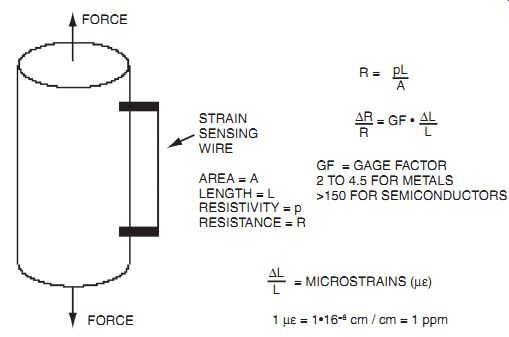
FIG. 2.2: Unbonded wire strain gage.
Bonded strain gages consist of a thin wire or conducting film arranged in a coplanar pattern and cemented to a base or carrier. The gage is normally mounted so that as much as possible of the length of the conductor is aligned in the direction of the stress that is being measured. Lead wires are attached to the base and brought out for inter connection. Bonded devices are considerably more practical and are in much wider use than unbonded devices.
Perhaps the most popular version is the foil-type gage, produced by photo-etching techniques, and using similar metals to the wire types (alloys of copper-nickel (Constantan), nickel-chromium (Nichrome), nickel-iron, platinum-tungsten, etc. (See FIG. 2.4). Gages having wire sensing elements present a small surface area to the specimen; this reduces leakage currents at high temperatures and permits higher isolation potentials between the sensing element and the specimen. Foil sensing elements, on the other hand, have a large ratio of surface area to cross-sectional area and are more stable under extremes of temperature and prolonged loading. The large surface area and thin cross section also permit the device to follow the specimen temperature and facilitate the dissipation of self-induced heat.
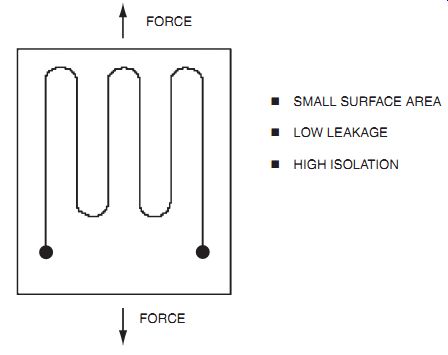
FIG. 2.3: Bonded wire strain gage.

FIG. 2.4: Metal foil strain gage.

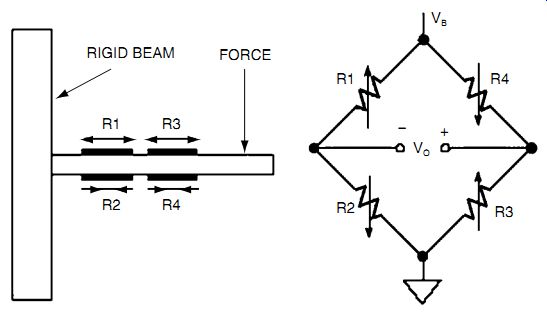
FIG. 2.6: Strain gage beam force sensor.
Strain gages are low-impedance devices; they require significant excitation power to obtain reasonable levels of output voltage. A typical strain-gage based load cell bridge will have (typically) a 350 ohm impedance and is specified as having a sensitivity in terms of millivolts full scale per volt of excitation. The load cell is composed of four individual strain gages arranged as a bridge as shown in FIG. 2.7. For a 10 V bridge excitation voltage with a rating of 3 mV/V, 30 millivolts of signal will be avail able at full scale loading. The output can be increased by increasing the drive to the bridge, but self-heating effects are a significant limitation to this approach: they can cause erroneous readings or even device destruction. Many load cells have "sense" connections to allow the signal conditioning electronics to compensate for DC drops in the wires. Some load cells have additional internal resistors which are selected for temperature compensation.
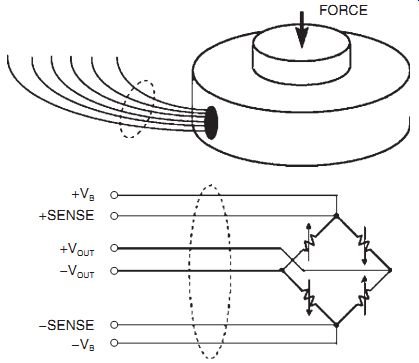
FIG. 2.7: Six-lead load cell.
Pressure Sensors
Pressures in liquids and gases are measured electrically by a variety of pressure transducers. A variety of mechanical converters (including diaphragms, capsules, bellows, manometer tubes, and Bourdon tubes) are used to measure pressure by measuring an associated length, distance, or displacement, and to measure pressure changes by the motion produced.
The output of this mechanical interface is then applied to an electrical converter such as a strain gage or piezoelectric transducer. Unlike strain gages, piezoelectric pressure transducers are typically used for high-frequency pressure measurements (such as sonar applications or crystal microphones).
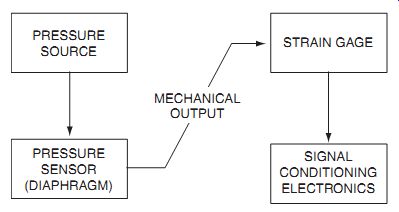
FIG. 2.8: Pressure sensors.
BENDING VANE WITH STRAIN GAGE
There are many ways of defining flow (mass flow, volume flow, laminar flow, turbulent flow). Usually the amount of a substance flowing (mass flow) is the most important, and if the fluid's density is constant, a volume flow measurement is a useful substitute that is generally easier to perform. One commonly used class of transducers, which measures flow rate indirectly, involves the measurement of pres sure. FIG. 2.9 shows a bending vane with an attached strain gage placed in the flow to measure flow rate.
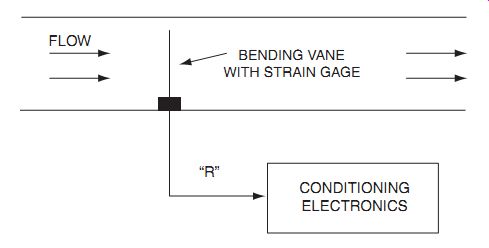
FIG. 2.9: Bending vane with strain gage used to measure flow rate.
Bridge Signal Conditioning Circuits
An example of an all-element varying bridge circuit is a fatigue monitoring strain sensing circuit as shown in FIG. 2.10. The full bridge is an integrated unit that can be attached to the surface on which the strain or flex is to be measured. In order to facilitate remote sensing, current excitation is used. The OP177 servos the bridge current to 10 mA around a reference voltage of 1.235 V. The strain gauge produces an output of 10.25 mV/1000 µe. The signal is amplified by the AD620 instrumentation amplifier which is configured for a gain of 100. Full-scale strain voltage may be set by adjusting the 100 ohm gain potentiometer such that, for a strain of -3500 µE, the out put reads -3.500 V; and for a strain of +5000 µE, the output registers +5.000 V. The measurement may then be digitized with an ADC which has a 10 V full-scale input range. The 0.1 µF capacitor across the AD620 input pins serves as an EMI/RFI filter in conjunction with the bridge resistance of 1 k ohm. The corner frequency of the filter is approximately 1.6 kHz.
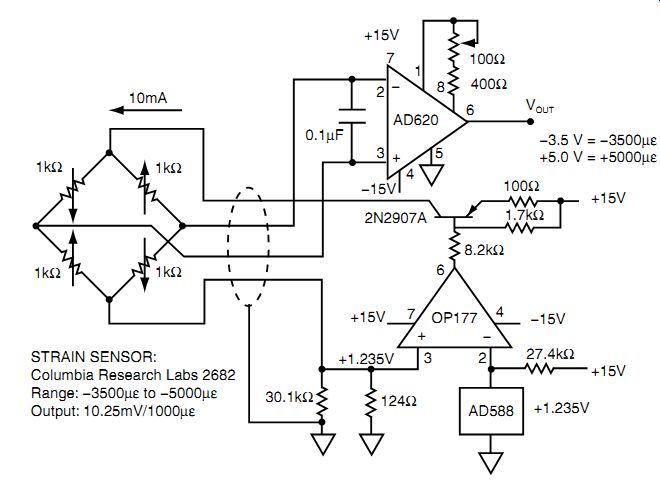
FIG. 2.10: Precision strain gage sensor amplifier.
Another example is a load cell amplifier circuit shown in FIG. 2.11. A typical load cell has a bridge resistance of 350 ohm. A 10.000 V bridge excitation is derived from an AD588 precision voltage reference with an OP177 and 2N2219A used as a buffer. The 2N2219A is within the OP177 feedback loop and supplies the necessary bridge drive current (28.57 mA). To ensure this linearity is preserved, an instrumentation amplifier is used. This design has a minimum number of critical resistors and amplifiers, making the entire implementation accurate, stable, and cost effective. The only requirement is that the 475 ohm resistor and the 100 ohm potentiometer have low temperature coefficients so that the amplifier gain does not drift over temperature.

FIG. 2.11: Precision load cell amplifier.
As has been previously shown, a precision load cell is usually configured as a 350 ohm, bridge. FIG. 2.12 shows a precision load-cell amplifier that is powered from a single supply. The excitation voltage to the bridge must be precise and stable, other wise it introduces an error in the measurement. In this circuit, a precision REF195 5 V reference is used as the bridge drive. The REF195 reference can supply more than 30mA to a load, so it can drive the 350 ohm bridge without the need of a buffer. The dual OP213 is configured as a two op amp in-amp with a gain of 100. The resistor network sets the gain according to the formula:

For optimum common-mode rejection, the resistor ratios must be precise. High tolerance resistors (±0.5% or better) should be used.
For a zero volt bridge output signal, the amplifier will swing to within 2.5 mV of 0 V. This is the minimum output limit of the OP213. Therefore, if an offset adjustment is required, the adjustment should start from a positive voltage at VREF and adjust VREF downward until the output (VOUT) stops changing. This is the point where the amplifier limits the swing. Because of the single supply design, the amplifier cannot sense signals which have negative polarity. If linearity at zero volts input is required, or if negative polarity signals must be processed, the VREF connection can be connected to a voltage which is mid-supply (2.5 V) rather than ground. Note that when VREF is not at ground, the output must be referenced to VREF.
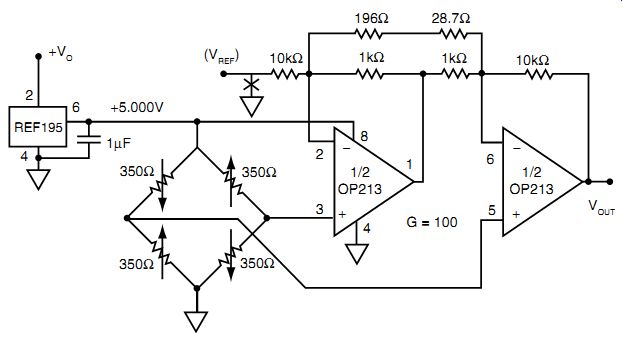
FIG. 2.12: Single supply load cell amplifier.
The AD7730 24-bit sigma-delta ADC is ideal for direct conditioning of bridge outputs and requires no interface circuitry. The simplified connection diagram is shown in FIG. 2.13. The entire circuit operates on a single +5 V supply which also serves as the bridge excitation voltage. Note that the measurement is ratiometric because the sensed bridge excitation voltage is also used as the ADC reference. Variations in the +5 V supply do not affect the accuracy of the measurement.
The AD7730 has an internal programmable gain amplifier which allows a full-scale bridge output of ±10mV to be digitized to 16-bit accuracy. The AD7730 has self and system calibration features which allow offset and gain errors to be minimized with periodic recalibrations. A "chop" mode option minimizes the offset voltage and drift and operates similarly to a chopper-stabilized amplifier. The effective input voltage noise RTI is approximately 40 nV rms, or 264 nV peak-to-peak. This corresponds to a resolution of 13 ppm, or approximately 16.5-bits. Gain linearity is also approximately 16-bits.

FIG. 2.13: Load cell application using the AD7730 ADC.

FIG. 2.14: Performance of AD7730 load cell ADC.
References
1. Ramon Pallas-Areny and John G. Webster, Sensors and Signal Conditioning, John Wiley, New York, 1991.
2. Dan Sheingold, Editor, Transducer Interfacing Handbook, Analog Devices, Inc., 1980.
3. Walt Kester, Editor, 1992 Amplifier Applications Guide, Section 2, 3, Analog Devices, Inc., 1992.
4. Walt Kester, Editor, System Applications Guide, Section 1, 6, Analog Devices, Inc., 1993.
5. Harry L. Trietley, Transducers in Mechanical and Electronic Design, Marcel Dekker, Inc., 1986.
6. Jacob Fraden, Handbook of Modern Sensors, Second Edition, Springer- Verlag, New York, NY, 1996.
7. The Pressure, Strain, and Force Handbook, Vol. 29, Omega Engineering, One Omega Drive, P.O. Box 4047, Stamford CT, 06907-0047, 1995. ( www.omega.com)
8. The Flow and Level Handbook, Vol. 29, Omega Engineering, One Omega Drive, P.O. Box 4047, Stamford CT, 06907-0047, 1995. ( www.omega.com)
9. Ernest O. Doebelin, Measurement Systems Applications and Design, Fourth Edition, McGraw-Hill, 1990.
10. AD7730 Data Sheet, Analog Devices, www.analog.com.
3. Strain Gage Sensor Installations
The various types of strain gages covered elsewhere in this book can be installed by a variety of different methods. This section will attempt to provide some detail on each of the more popular methods of installation using the most popular strain gage types (bonded foil resistance strain gages and free filament strain gages). The reader is encouraged to study more about the methods that are of interest, as not all of the intricacies of the installation techniques can be covered in this brief section. Please be aware that there is a definite art to installing strain gages as it is primarily a manual process, and particularly with the esoteric, free filament strain gage installations, the quality of the installation is dependent to some degree on the installer's experience and is not entirely based on whether or not the proper steps were followed. There are various modifications to the following installation techniques based on exact requirements, environment, etc., but these can be considered general installation technique guidelines.
There are methods of installing strain gages in which the strain gage is actually created during the installation process. This type of installation is commonly referred to as vacuum depositing or sputtering. This particular installation technique is not considered part of the general strain gage installation methods and is only covered briefly at the end of this section.
We will break down the strain gage installations into three broad categories: General Stress Analysis, Precision Transducer Installations, and Elevated Temperature Installations. The final section will be on specialty installations and will briefly make mention of other types of installations.
General Stress Analysis Installation (Bonded Foil Strain Gage) For general stress analysis, the user is primarily interested in obtaining stress/strain data as fast as possible and as accurately as possible. Examples of this are FEA model validation, general design validation, structural failure analysis, simple accelerated life cycle testing, etc. These types of installations usually do not warrant the same type of manufacturing methods as a high performance and high accuracy transducer (for example, a post cure operation).
The most common method of installation for a bonded foil resistance strain gage in this category is using a room temperature cure cyanoacrylate adhesive consisting of a catalyst and an adhesive. This type of installation requires a minimum amount of tools and equipment and also a minimum amount of experience. The basic procedure is as follows:
a. Surface preparation, either a chemical cleaning process or a combination of fine grit abrasive and chemical cleaning. It should be noted that in some types of tests, the surface being measured must not be altered, which dictates a chemical cleaning only.
b. Gage location centerlines or layout lines are burnished on the part using a method that will not cause bumps or other anomalies under the gage grid after installation. Examples of this can be simply a pencil, a scribe tool with a brass tip, etc. In some cases the layout lines can be applied using laser marking.
c. The gage is now carefully placed in position and held in place using a piece of Mylar® tape. lt is sometimes desirable not to seal the strain gage coupon on all four sides with the tape. This is to allow "squeeze out" of the adhesive and provide a uniform bond line with no bumps or air pockets. Carefully lift back the Mylar tape with gage adhered to the tape and fold it back over itself exposing the bottom or bondable surface of the strain gage.
d. The catalyst is now applied to the gage backing, while the adhesive is applied to the component surface.
e. Fold the gage back in place, and using thumb pressure, press and hold the gage per the manufacturer's recommended guidelines, usually at least one minute.
At this point, the strain gage is bonded to the component and is ready for the next step, which is lead wire attachment. The lead wire length and material is selected based on the user's test and instrumentation requirements. A suitable coating must be installed as well in order to seal the installation from the environment and also to provide some mechanical protection.
This is the most basic installation technique, and care must be taken when choosing the strain gage itself. Parameters to consider include: grid length and type, backing and foil type, resistance, self-temperature compensation rating, etc. General stress analysis applications can also utilize the higher quality and higher capability of heat cured epoxy adhesive systems that are more commonly utilized in transducer applications.
Precision Transducer Installations
These installations cover a wide range of transducers, from torque transducers to shear beams to pressure transducers. Also included in this section would be the ever-popular component "transducerization" which includes the in-situ components that are slightly modified to accept strain gages and they become the transducer. An example of this is the suspension "pushrods" on an open wheel racecar. In this case, the actual suspension pushrods have a couple pockets milled into it in which strain gages are installed and the pushrod itself becomes a transducer that the team can use to determine optimum suspension setup prior to a race.
These types of installations require better adhesives and routinely utilize heat cure epoxy adhesives. Various types are available depending on operating temperature of the transducer, surface porosity of the base transducer material, and so forth.
The general procedure, for bonded foil resistance strain gages, follows some similar steps as the general stress analysis installations:
a. Surface preparation, usually a fine grit abrasive blast is used. Chemical cleaning is also required prior to the actual strain gage application in order to ensure a contamination-free surface.
b. Gage location centerlines are burnished on the part using a method that will not cause bumps or other anomalies under the gage grid after installation.
Examples of this can be simply a pencil, a scribe tool with a brass tip, etc. In some cases the layout lines can be applied using laser marking.
c. The gage is now carefully placed in position and held in place using a piece of Mylar tape. It is sometimes desirable to not seal the strain gage coupon on all four sides with the tape. This is to allow "squeeze out" of the adhesive and provide a uniform bond line with no bumps or air pockets. Carefully lift back the Mylar tape with gage adhered to the tape and fold it back over itself exposing the bottom or bondable surface of the strain gage.
d. The adhesive is now applied to the gage backing and the component. Allow to air dry per the manufacturer's recommended guidelines.
e. Fold the gage back in place, place a piece of Teflon® film over the Mylar tape, and place a suitably sized rubber pad over the Teflon film.
f. A critical part of the installation is using the correct clamping pressure to clamp the gage. Each adhesive has a recommended clamping pressure for precision transducer applications. It should also be noted that some applications require more than the recommended pressure. This author is aware of an application that required more than twice the manufacturer's recommended clamp pressure in order to meet certain specifications such as creep performance. The clamp should also be calibrated and of a suitable design that allows for efficient clamping and unclamping if used for production type work. The clamped transducer is then placed in an oven and allowed to ramp up at a controlled rate to the desired cure temperature. A common type of installation on a steel transducer body, for instance, would require a cure of 2 hours at 350°F.*
g. The next step in the procedure is the post cure. This is important for long-term stable transducer operation. Allow the transducer to cool after the cure operation and remove the clamp. Place the transducer back in the oven and post cure the transducer (with no clamp) at 50°F over either the cure temperature or the maximum operating temperature, whichever is higher.
h. After installation, the gages are wired as appropriate, usually in a Wheatstone bridge configuration. Further transducer manufacturing steps occur but are outside of the scope of this section.
Elevated Temperature Installations
Installations under this category cover installations for use over about 700°F. For that reason they require the use of free filament wire strain gages. It should also be noted that at these higher temperatures, essentially the only measurements that can be made with any certainty are dynamic measurements, as opposed to static. Some static measurements are said to have been made up to 1200°F, but this author does not know the accuracies and repeatability of those measurements.
The following are general procedures to be followed for free filament strain gage applications. As in the other installation categories covered, there can be variations to this based on material requirements, experience, etc. For this type of installation in particular, the installer's experience and skill are critical to a quality installation that will survive the rigors of a jet engine spin pit test, for instance.
These strain gages can be installed using two different methods, either using ceramic cement, or via a ROKIDE® flame spray process. Ceramic cement is usually utilized for applications below 1200°F, where the use of the flame spray process would pro vide unwanted reinforcement to a thin specimen, and also where the installer cannot spray due to space constraints. The ROKIDE process provides better erosion characteristics over ceramic cement but does not perform as well in fatigue as ceramic cements do. ROKIDE is essentially aluminum oxide and comes in various purity levels.
The basic procedures are as follows:
Ceramic Cement Process
This process utilizes ceramic cement which, when applied in the appropriate steps, ultimately encapsulates the free filament strain gage grid in ceramic cement, which protects the strain gage from the harsh elevated temperature environment.
a. Where possible, pre-bake the component to eliminate any surface oils, etc.
b. Carefully burnish the surface of the component extending the lines beyond the area to be grit blasted. This area would include the entire area where the strain gage grid is applied as well as the lead wire routing areas that require ceramic cement application.
c. Mask the component with tape for the gage locations and lead wire paths. Grit blast using a pressure blaster using new grit of suitable size for the particular component.
d. Remove all tape and inspect for contaminants.
e. Mask the outline of the gage location and lead wire routing areas with Mylar tape. Apply a pre-coat of ceramic cement per manufacturer's guidelines to both areas. After the cement has air dried for a nominal length of time, remove the Mylar tape. Oven cure the pre-coat per manufacturer's guidelines.
f. The strain gages themselves come from the manufacturer on a slide with integral mastic, which holds the gage shape. Carefully remove the gage from the manufacturer's slide and position the gage over the correct gage location.
g. Carefully press the mastic into contact with the pre-coat using fine-tipped tweezers or other suitable tool.
h. Using a clean brush, apply ceramic cement in thin layers over the exposed grid and lead wires in between the tape bars. Allow to air dry and place in an oven for cure per the manufacturer's guidelines.
i. Verify the gage resistance and remove the remaining tape bars.
j. Apply a thin layer of ceramic cement over the newly exposed areas of the grid and lead wires. Allow to air dry and place in an oven for cure per the manufacturer's guidelines.
k. Once all lead wires have been attached, perform final electrical inspection by checking the resistance of the circuit, as well as the insulation resistance.
l. A typical ceramic cement installation of this type is between 0.007” to 0.008” thick.
ROKIDE Flame Spray Process
This process utilizes a special spray gun which, using oxygen and acetylene and the appropriate grade of ROKIDE rod, sprays a molten ceramic onto the desired surface.
This ultimately encapsulates the strain gage grid and protects it from the harsh elevated temperature environment.
a. Where possible, pre-bake the component to eliminate any surface oils, etc.
b. Carefully burnish the surface of the component extending the lines beyond the area to be grit blasted. This area would include the entire area where the strain gage grid is applied as well as the lead wire routing areas that require ROKIDE flame spray application.
c. Mask the component with suitable tape for the gage locations and lead wire paths. Grit blast using a pressure blaster using new grit of suitable size for the particular component. Clean with dry, contamination-free air.
d. Apply a thin nickel aluminide base coat. The nickel aluminide retards oxidation and also provides a better mechanical bond for the aluminum oxide (ROKIDE). Clean with dry, contamination-free air.
e. Apply a thin aluminum oxide pre-coat, which will electrically insulate the free filament strain gage from the component surface. Clean with dry, contamination-free air.
f. The strain gages themselves come from the manufacturer on a slide with integral mastic, which holds the gage shape. Carefully remove the gage from the manufacturer's slide and position the gage over the correct gage location.
g. Carefully press the mastic into contact with the pre-coat using fine-tipped tweezers or other suitable tool. Ensure the gage grid is not pressed too hard so as to conform it to the aluminum oxide pre-coat.
h. Box in the gage grid by placing tape around the perimeter of the grid using suitable high temperature tape. This ensures that only a minimum amount of surface area will be covered by the aluminum oxide, which does cause a rein forcing effect.
i. Apply a light aluminum oxide tack-coat to the exposed gage grid and gage leads. Always take resistance readings throughout the process to ensure the gage grid has not become damaged.
j. Remove the perimeter tape first, and then the tape bars which were originally holding the strain gage grid to the aluminum oxide pre-coat.
k. Box in the installation again using the same tape as in the previous operation. This second application of perimeter tape should be positioned about 1/32? beyond the first tape application. This will provide a layering effect, which will minimize the sharp edge of the final aluminum oxide installation.
l. Spray the final coat of aluminum oxide over the entire strain gage and strain gage leads as appropriate.
m. Remove all tape and inspect for circuit resistance and insulation resistance.
n. A typical ROKIDE installation of this type is generally about 0.012? thick.
Other Installation Methods
One unique method of strain gage installation requires specialized manufacturing equipment and technical knowledge. This is referred to as sputtering or vacuum deposition. During this process the strain gage itself is created during the installation process. It is beyond this scope of this section to address this specialized method of installation.
Another specialized method is called thick film, which again is outside of the scope of this section.
These two methods are considered specialized and have been covered in the relevant section of the strain sensor SECTION. In general they do not cover nearly as broad a range of applications as the three sections broken out above; therefore more attention has been given to the more common installations.
NEXT: Temperature Sensors
PREV: